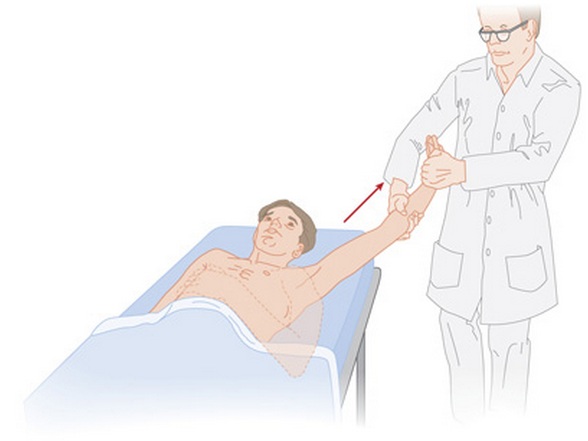Shoulder dislocation: Difference between revisions
No edit summary |
No edit summary |
||
| Line 1: | Line 1: | ||
==Background== | ==Anterior Dislocation== | ||
===Background=== | |||
*>99% are anterior dislocation assoc w/ indirect blow | *>99% are anterior dislocation assoc w/ indirect blow | ||
*Must rule-out axillary nerve injury | *Must rule-out axillary nerve injury | ||
*Consider intra-articular lidocaine (10-20mL) as alternative to procedural sedation | *Consider intra-articular lidocaine (10-20mL) as alternative to procedural sedation | ||
==Clinical Features== | ===Clinical Features=== | ||
*Arm held in abduction w/ shoulder lacking normal rounded contour | *Arm held in abduction w/ shoulder lacking normal rounded contour | ||
*Difficulty (painful) touching ipsilateral arm to contralateral shoulder | *Difficulty (painful) touching ipsilateral arm to contralateral shoulder | ||
==Imaging== | ===Imaging=== | ||
*Prereduction radiographs advised for traumatic mechanism (rule-out fx-dislocation) | *Prereduction radiographs advised for traumatic mechanism (rule-out fx-dislocation) | ||
*AP | *AP | ||
| Line 15: | Line 16: | ||
**Will show whether dislocation is anterior or posterior | **Will show whether dislocation is anterior or posterior | ||
==Reduction Techniques== | ===Management=== | ||
*Reduce (see techniques below) | |||
*Post-reduction: sling w/ shoulder in adduction/internal rotation | |||
*Ortho referral for 1st-time dislocation | |||
===Complications=== | |||
#Recurrent dislocation (>90% in age <20yr) | |||
#Bony injuries: | |||
##Usually do not affect management | |||
###Hill-Sachs lesion (compression fracture of humeral head) | |||
###Bankart lesion (injury to inferior glenoid labrum) | |||
#Axillary nerve (usually temporary) and artery (rare) | |||
#Rotator cuff tear | |||
===Reduction Techniques=== | |||
*Traction-Countertraction | *Traction-Countertraction | ||
[[File:Traction-Countertraction.jpg]] | [[File:Traction-Countertraction.jpg]] | ||
| Line 23: | Line 38: | ||
[[File:External Rotation.jpg]] | [[File:External Rotation.jpg]] | ||
==Posterior Dislocation== | |||
===Background=== | |||
*Via forceful internal rotation/adduction (sz, electric shock) or blow to ant shoulder | |||
*Neurovascular and rotator cuff tears are less common than in ant dislocations | |||
===Clinical Features== | |||
* | *Prominence of posterior shoulder and ant flattening of normal shoulder contour | ||
*Pt unable to rotate or abduct affected arm | |||
* | ===Imaging=== | ||
*Scapular "Y" view shows humeral head in posterior position | |||
===Management=== | |||
*Reduce | |||
**Traction applied to adducted arm in long axis of humerus | |||
**Assistant pushes humeral head anteriorly into glenoid fossa | |||
*Spling, ortho f/u | |||
==Inferior Dislocation== | |||
===Background=== | |||
*Assoc w/ significant soft tissue trauma or fracture | |||
*Via hyperabduction force which levers the humeral neck against the acromion | |||
== | ===Clinical Features=== | ||
*Pt p/w humerus fully abducted with hand on or behind the head | |||
*Humeral head can be palpated on lateral chest wall | |||
===Management=== | |||
*Reduce | |||
**Traction in upward and outward direction | |||
*Sling, ortho f/u (rotator cuff tear is the norm) | |||
==Source== | ==Source== | ||
*Tintinalli | *Tintinalli | ||
[[Category:Ortho]] | [[Category:Ortho]] | ||
Revision as of 03:08, 11 February 2012
Anterior Dislocation
Background
- >99% are anterior dislocation assoc w/ indirect blow
- Must rule-out axillary nerve injury
- Consider intra-articular lidocaine (10-20mL) as alternative to procedural sedation
Clinical Features
- Arm held in abduction w/ shoulder lacking normal rounded contour
- Difficulty (painful) touching ipsilateral arm to contralateral shoulder
Imaging
- Prereduction radiographs advised for traumatic mechanism (rule-out fx-dislocation)
- AP
- Will show dislocation
- Scapular lateral or "Y"
- Will show whether dislocation is anterior or posterior
Management
- Reduce (see techniques below)
- Post-reduction: sling w/ shoulder in adduction/internal rotation
- Ortho referral for 1st-time dislocation
Complications
- Recurrent dislocation (>90% in age <20yr)
- Bony injuries:
- Usually do not affect management
- Hill-Sachs lesion (compression fracture of humeral head)
- Bankart lesion (injury to inferior glenoid labrum)
- Usually do not affect management
- Axillary nerve (usually temporary) and artery (rare)
- Rotator cuff tear
Reduction Techniques
- Traction-Countertraction
- Milch
- External Rotation
Posterior Dislocation
Background
- Via forceful internal rotation/adduction (sz, electric shock) or blow to ant shoulder
- Neurovascular and rotator cuff tears are less common than in ant dislocations
=Clinical Features
- Prominence of posterior shoulder and ant flattening of normal shoulder contour
- Pt unable to rotate or abduct affected arm
Imaging
- Scapular "Y" view shows humeral head in posterior position
Management
- Reduce
- Traction applied to adducted arm in long axis of humerus
- Assistant pushes humeral head anteriorly into glenoid fossa
- Spling, ortho f/u
Inferior Dislocation
Background
- Assoc w/ significant soft tissue trauma or fracture
- Via hyperabduction force which levers the humeral neck against the acromion
Clinical Features
- Pt p/w humerus fully abducted with hand on or behind the head
- Humeral head can be palpated on lateral chest wall
Management
- Reduce
- Traction in upward and outward direction
- Sling, ortho f/u (rotator cuff tear is the norm)
Source
- Tintinalli





